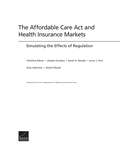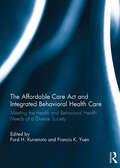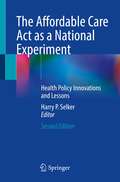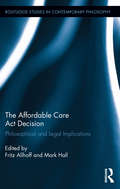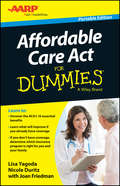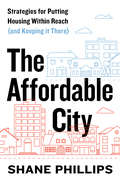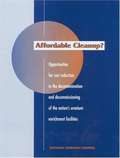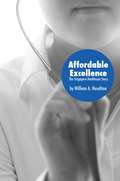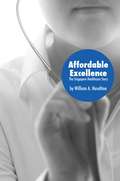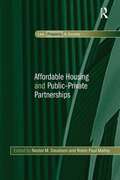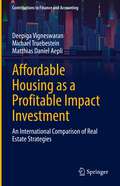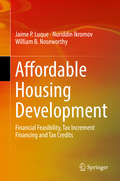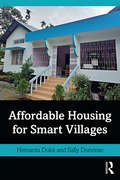- Table View
- List View
The Affordable Care Act and Health Insurance Markets: Simulating the Effects of Regulation
by Christine Eibner Amado Cordova Sarah A. Nowak Carter C. Price Evan Saltzman Dulani WoodsIn this report, the authors estimate the effects of the Affordable Care Act on health insurance enrollment and premiums for ten states (Florida, Kansas, Louisiana, Minnesota, New Mexico, North Dakota, Ohio, Pennsylvania, South Carolina, and Texas) and for the nation overall, with a focus on outcomes in the nongroup and small group markets.
The Affordable Care Act and Integrated Behavioural Health Care: Meeting the Health and Behavioral Health Needs of a Diverse Society
by Ford H. Kuramoto and Francis K. YuenThis book provides a scholarly discussion of arguably the most important advance in U.S. public health services since Medicare 50 years ago - how the Federal program known as the Patient Care and Affordable Care Act of 2010 (ACA) or "Obamacare" became law. It addresses ACA in terms of its impact on improving health and behavioural health services for key diverse populations in America, including people with disabilities, consumers, women, racial and ethnic minorities, and veterans and their families.From the very beginning, ACA was controversial and the topic of heated political debate at both state and national levels. This book examines more closely how the legislation was developed, including the political history of the act; the many advocacy efforts at the national level and the community-based action strategies at the grassroots level; how ACA will affect a broad cross-section of America; the integration of health and behavioural health services as a key component of ACA; the financing of ACA and parity for behavioural health services.This book was originally published as a special issue of the Journal of Social Work in Disability & Rehabilitation.
The Affordable Care Act as a National Experiment: Health Policy Innovations and Lessons
by Harry P. SelkerThe landmark 2010 Patient Protection and Affordable Care Act (ACA), or “Obamacare,” is a topic of great debate in mainstream, academic, and scientific media that generated strong opinions across the political spectrum and our nation. Soon after the enactment of the ACA and the fierce debate that ensued, The Affordable Care Act as a National Experiment was published by Springer in 2014. Now five years later, just finishing an election year in which the ACA was a hotly debated issue, the second edition of this title examines the history, lessons, and impact of this ground-breaking legislation. Now a decade since implementation nationally, the ACA is the largest healthcare policy innovation in the United States in at least 50 years and one of our nation’s largest healthcare experiments ever. The history of public health and medicine shows us that to develop better solutions for important health problems, we must innovate. And when we try a new strategy, we are reminded that to innovate is to experiment. This is the basis of all medical research, public health interventions, and health policy innovations. Moreover, in recent years, there is an increasing emphasis on “translational science,” research that always has an ultimate focus on having real impact on medical care and the public’s health – whether in translating from bench research to the bedside, or from limited clinical use into widespread practice, public health interventions or policy.As with the previous edition, the book opens with a chapter that gives a basic overview of The Affordable Care Act. The second chapter, which previously discussed the objectives of the ACA, now takes a look at the successes, unfinished work and impact of the ACA in the past ten years. The third chapter now ponders the question of whether the ACA has protected patients since its implementation while its previous counterpart gave predictions for the future. The chapters that follow highlight things such as Medicaid expansion and insurance reform under the ACA, the Supreme Court Review of the ACA, social determinants of health, stories of the uninsured and stabilization of the ACA, among others. The book rounds out with a summary of what’s next and the push for universal healthcare followed by an epilogue. Due to the timely nature of the subject matter, some chapters from the previous edition have been dropped and seven new chapters have been added in their place. The remaining seven chapters from the previous edition have also been fully revised and updated. Written by nationally known healthcare policy leaders who were involved directly in the creation and implementation of the ACA, the second edition of The Affordable Care Act as a National Experiment again will examine the history and impact of this ground-breaking legislation as well as recommend priorities, objectives, and next steps for translational research. It is an essential resource for all healthcare providers as well as policy makers and academics.
The Affordable Care Act (B): Industry Negotiations
by Michael Norris Joseph L. BowerIn 2009, The Obama administration and Senator Max Baucus, chairman of the Senate Finance Committee enter into talks with industry groups that will be effected by the health reform that the Congress is working on.
The Affordable Care Act (C): Legislative Strategy in the Senate
by Michael Norris Joseph L. BowerIn 2009, the Senate begins drafting its health care bills. Jurisdiction in the Senate is shared between two committees, but the more important is the Senate Finance Committee.
The Affordable Care Act (D): Making a Decision on the Employer-Sponsored Health Insurance Tax Exclusion
by Michael Norris Joseph L. BowerIn the summer of 2009, a meeting is called in the White House to discuss the impact of changing the rules on the employer-sponsored health insurance tax exclusion.
The Affordable Care Act Decision: Philosophical and Legal Implications (Routledge Studies in Contemporary Philosophy)
by Fritz Allhoff Mark HallInterest in NFIB v. Sebelius has been extraordinarily high, from as soon as the legislation was passed, through lower court rulings, the Supreme Court’s grant of certiorari, and the decision itself, both for its substantive holdings and the purported behind-the-scene dynamics. Legal blogs exploded with analysis, bioethicists opined on our collective responsibilities, and philosophers tackled concepts like ‘coercion’ and the activity/inactivity distinction. This volume aims to bring together scholars from disparate fields to analyze various features of the decision. It comprises over twenty essays from a range of academic disciplines, namely law, philosophy, and political science. Essays are divided into five units: context and history, analyzing the opinions, individual liberty, Medicaid, and future implications.
The Affordable Care Act (E): The August 2009 Recess
by Michael Norris Joseph L. BowerDuring the Congress's August recess in 2009, the Tea Party makes a big push to stop the health reform bill moving through Congress.
The Affordable Care Act (F): Regaining Momentum
by Michael Norris Joseph L. BowerIn the fall of 2009, President Obama makes a speech to a joint session of Congress in an attempt to regain lost momentum on health reform and get a bill through Congress.
Affordable Care Act For Dummies
by Nicole Duritz Lisa Yagoda Joan FriedmanAn essential and easy-to-understand guide to the Affordable Care ActThe Affordable Care Act For Dummies is your survival guide to understanding the changes in our health care system and how they benefit you. Written in down-to-earth language, this handy resource outlines new protections under the Affordable Care Act, and walks you through what you--as an individual or an employer--need to do to select the best health insurance plan for your needs. With this book, you get answers to your top questions about how the law applies to you.The folks that bring you the For Dummies line of useful, educational books have teamed up with AARP to give you a hands-on guide that offers insight into how to make the right decisions about health care and improve your quality of life. It is filled with examples, ideas, and information as well as useful takeaways to help you take full advantage of the reforms.Uncover the 10 essential benefits of the Affordable Health Care ActReceive guidance on what will improve if you already have insurance coverageIf you don't have coverage, determine which insurance program is right for you and your family and whether you're eligible for financial assistanceFind out what changes businesses large and small can anticipateLearn how to avoid scammers who are taking advantage of consumers' confusionUse this complete guide to get the facts about the Affordable Care Act, clear up any misconceptions you may have about the law, and prepare for the health care choices ahead.
The Affordable Care Act (G): The Final Votes
by Michael Norris Joseph L. BowerIn the fall of 2009, the House and Senate each voted to pass health reform bills. These bills then had to be combined into the Affordable Care Act and the ACA had to be passed by both houses. Reconciliation had to be used because of Republican Scott Brown's Senate victory in Massachusetts.
The Affordable Care Act (H): Implementation Begins
by Michael Norris Joseph L. BowerIn the spring of 2010, after the ACA is signed into law, the government begins implementation.
The Affordable Care Act (I): The Supreme Court
by Michael Norris Joseph L. BowerIn the spring of 2012, the Supreme Court hears arguments and releases its decision on the constitutionality of the ACA.
The Affordable Care Act (J): Healthcare.gov
by Michael Norris Joseph L. BowerIn the fall of 2013, Healthcare.gov launches as an insurance exchange for consumers to buy health insurance. The launch is filled with glitches, and some worry if it will imperil the fate of the entire ACA.
The Affordable City: Strategies for Putting Housing Within Reach (and Keeping it There)
by Shane PhillipsFrom Los Angeles to Boston and Chicago to Miami, US cities are struggling to address the twin crises of high housing costs and household instability. Debates over the appropriate course of action have been defined by two poles: building more housing or enacting stronger tenant protections. These options are often treated as mutually exclusive, with support for one implying opposition to the other.Shane Phillips believes that effectively tackling the housing crisis requires that cities support both tenant protections and housing abundance. He offers readers more than 50 policy recommendations, beginning with a set of principles and general recommendations that should apply to all housing policy. The remaining recommendations are organized by what he calls the Three S's of Supply, Stability, and Subsidy. Phillips makes a moral and economic case for why each is essential and recommendations for making them work together.There is no single solution to the housing crisis—it will require a comprehensive approach backed by strong, diverse coalitions. The Affordable City is an essential tool for professionals and advocates working to improve affordability and increase community resilience through local action.
Affordable Cleanup?: Opportunities for cost reduction in the decontamination and decommissioning of the nation's uranium enrichment facilities
by Committee on Decontamination Decommissioning of Uranium Enrichment FacilitiesThe Energy Policy Act of 1992 called on the National Academy of Sciences to conduct a study and provide recommendations for reducing the costs of decontaminating and decommissioning (D&D) the nation's uranium enrichment facilities located at Oak Ridge, Tennessee; Raducah, Kentucky; and Portsmouth, Ohio. This volume examines the existing plans and cost estimates for the D&D of these facilities, including such elements as technologies, planning and management, and identifies approaches that could reduce D&D costs. It also assesses options for disposition of the large quantities of depleted uranium hexafluoride that are stored at these sites.
Affordable Excellence: The Singapore Healthcare Story - How to Create and Manage Sustainable Healthcare Systems
by William A. HaseltineThe United States has been struggling with its health care system for decades. Costs continue to spiral upward, while coverage of the population has decreased because of job losses and the resultant loss of health benefits, due to the Great Recession and the subsequent slow economic recovery. President Clintons attempt to enact a national health care plan failed, and the fate of President Obamas health care plan, under attack since its inception, is uncertain. Since achieving independence, Singapore undertook the monumental task of transforming itself to a modern, prosperous, secure city-state. Many institutions needed to be erected to reach this goal, but one that stands out and is the subject of this book was the need for a world class health care system. "Affordable Excellence" examines how Singapore succeeded in its efforts, setting up a health system that has become one of the best in the world, delivering high quality care at a fraction of the cost of most First World systems. Ranked 6th globally on performance, Singapore spends less than 4% of GDP on health care (in contrast to the U. S. , for example, which spends over 17% of GDP). How did Singapore do it? What can be learned from its achievement? What lessons can be put to use by the developing, and the most-developed, nations building new health care systems? This book provides answers. It explores the underlying social philosophy and basic approach that Singapore used to set up its system and, at the heart of the Singapore model, its system of health savings accounts and insurance programs that ensure no one would be without the means to buy quality care.
Affordable Excellence
by William A. HaseltineThis is the story of the Singapore healthcare system: how it works, how it is financed, its history, where it is going, and what lessons it may hold for national health systems around the world. Singapore ranks sixth in the world in healthcare outcomes, yet spends proportionally less on healthcare than any other high-income country. This is the first book to set out a comprehensive system-level description of healthcare in Singapore, with a view to understanding what can be learned from its unique system design and development path.The lessons from Singapore will be of interest to those currently planning the future of healthcare in emerging economies, as well as those engaged in the urgent debates on healthcare in the wealthier countries faced with serious long-term challenges in healthcare financing. Policymakers, legislators, public health officials responsible for healthcare systems planning, finance and operations, as well as those working on healthcare issues in universities and think tanks should understand how the Singapore system works to achieve affordable excellence.
Affordable Excellence: The Singapore Healthcare Story
by William A. HaseltineThis is the story of the Singapore healthcare system: how it works, how it is financed, its history, where it is going, and what lessons it may hold for national health systems around the world. Singapore ranks sixth in the world in healthcare outcomes, yet spends proportionally less on healthcare than any other high-income country. This is the first book to set out a comprehensive system-level description of healthcare in Singapore, with a view to understanding what can be learned from its unique system design and development path.The lessons from Singapore will be of interest to those currently planning the future of healthcare in emerging economies, as well as those engaged in the urgent debates on healthcare in the wealthier countries faced with serious long-term challenges in healthcare financing. Policymakers, legislators, public health officials responsible for healthcare systems planning, finance and operations, as well as those working on healthcare issues in universities and think tanks should understand how the Singapore system works to achieve affordable excellence.
Affordable Excellence: The Singapore Health System
by William A. HaseltineThis is the story of the Singapore healthcare system: how it works, how it is financed, its history, where it is going, and what lessons it may hold for national health systems around the world. Singapore ranks sixth in the world in healthcare outcomes, yet spends proportionally less on healthcare than any other high-income country. This is the first book to set out a comprehensive system-level description of healthcare in Singapore, with a view to understanding what can be learned from its unique system design and development path.The lessons from Singapore will be of interest to those currently planning the future of healthcare in emerging economies, as well as those engaged in the urgent debates on healthcare in the wealthier countries faced with serious long-term challenges in healthcare financing. Policymakers, legislators, public health officials responsible for healthcare systems planning, finance and operations, as well as those working on healthcare issues in universities and think tanks should understand how the Singapore system works to achieve affordable excellence.
Affordable Housing and Low Income Housing Tax Credits in the United States
by Arthur I Segel Nicolas P. RetsinasIndustry and Background Note
Affordable Housing and Public-Private Partnerships (Law, Property and Society)
by Nestor M. DavidsonWith distressing statistics about rising cost burdens, increasing foreclosure rates, rising unemployment, falling wages, and widespread homelessness, building affordable housing is one of our most pressing social policy problems. Affordable Housing and Public-Private Partnerships focuses attention on this critical need, as leading experts on affordable housing law and policy come together to address key issues of concern and to suggest appropriate responses for future action. Focusing in particular on how best to understand and implement the joint work of public and private actors in housing, this book considers the real estate aspects of affordable housing law and policy, access to housing, housing finance and affordability, land use, housing regulation and housing issues in a post-Katrina context. Filling a critical gap in the scholarly literature available, this book will be of particular interest to policy-makers, academics, lawyers and students of housing, land use, real estate, property, community development and urban planning
Affordable Housing as a Profitable Impact Investment: An International Comparison of Real Estate Strategies (Contributions to Finance and Accounting)
by Deepiga Vigneswaran Michael Truebestein Matthias Daniel AepliThe challenges of affordable housing are manifold. However this presents an opportunity to private investors, real estate companies, and developers. With the growing global trend for impact-based investments, many institutional investors have begun to consider the merits of this asset class. This book examines not only the profitability of these assets, but also whether these assets rely on government subsidy. It discusses why investors have become more interested in this product and which investment criteria influence the financial performance of these assets. The authors employed a mixed method approach to collect data at two tiers, first through surveys and afterwards through interviews of 8 firms (3 publicly listed companies, 3 private equity companies, 1 foundation, and 1 state bank) across Germany, the United Kingdom, and the United States. Investment criteria are analyzed using inferential statistics, specifically the Hierarchical Algorithm Cluster Analysis. The financial characteristics of the companies are examined and compared using descriptive statistics and the qualitative interview output is explored using the thematic Latent Coding Analysis. Furthermore, the book explains how the bond-like nature of affordable housing is a profitable impact investment option, and how this strategy is particularly worthwhile for institutional investors. It also describes that profitability of affordable housing products is not dependent on subsidy. Still, affordable housing products supported by government incentives in the United Kingdom and United States are most attractive. The book illustrates six important investment strategies identified by veterans in this field to have an influence on the financial feasibility of affordable housing products.
Affordable Housing Development: Financial Feasibility, Tax Increment Financing and Tax Credits
by Jaime P. Luque Nuriddin Ikromov William B. NoseworthyThis book explains the nuts and bolts of affordable housing development. Divided into two complementary sections, the book first provides an overview of the effectiveness of existing federal and state housing programs in the United States, such as the LIHTC and TIF programs. In turn, the book’s second section presents an extensive discussion of and insights into the financial feasibility of an affordable real estate development project. Researchers, policymakers and organizations in the public, private and nonprofit sectors will find this book a valuable resource in addressing the concrete needs of affordable housing development. “Luque, Ikromov, and Noseworthy’s new book on Affordable Housing Development is a “must read” for all those seeking to address the growing and vexing problem of affordable housing supply. The authors provide important insights and practical demonstration of important financial tools often necessary to the financial feasibility of such projects, including tax-increment financing and the Low-Income Housing Tax Credit. Further, the authors provide important backdrop to the affordability crisis and homelessness. I highly recommend this book to all who seek both to articulate and enhance housing access.” By Stuart Gabriel, Arden Realty Chair, Professor of Finance and Director, Richard S. Ziman Center for Real Estate at UCLA"Over several years Jaime Luque, Nuriddin Ikromov and William Noseworthy applied their analytical bent, and no small measure of empathy, to homelessness as actually experienced in Madison, Wisconsin – and they inspired multiple classes of urban economics students to join them. “Homelessness” is a complex web of issues affecting a spectrum of populations, from individuals struggling with addiction or emotional disorders, to families who’ve been dealt a bad hand in an often-unforgiving economy. Read this book to follow Jaime, Nuriddin, and William as they evaluate a panoply of housing and social programs, complementing the usual top-down design perspective with practical analysis of the feasibility of actual developments and their effectiveness. Analytical but written for a broad audience, this book will be of interest to anyone running a low-income housing program, private and public developers, students, and any instructor designing a learning-by-doing course that blends rigor with real-world application to a local problem."By Stephen Malpezzi, Professor Emeritus, James A. Graaskamp Center for Real Estate, Wisconsin School of Business, University of Wisconsin-Madison, and Dean, Weimer School of the Homer Hoyt Institute.
Affordable Housing for Smart Villages
by Hemanta Doloi Sally DonovanThis book initiates a fresh discussion of affordability in rural housing set in the context of the rapidly shifting balance between rural and urban populations. It conceptualises affordability in rural housing along a spectrum that is interlaced with cultural and social values integral to rural livelihoods at both personal and community level. Developed around four intersecting themes: explaining houses and housing in rural settings; exploring affordability in the context of aspirations and vulnerability; rural development agendas involving housing and communities; and construction for resilience in rural communities, the book provides an overview of some of the little understood and sometimes counter-intuitive best practices on rural affordability and affordable housing that have emerged in developing economies over the last thirty years. Drawing on practice-based evidence this book presents innovative ideas for harnessing rural potential, and empowering rural communities with added affordability and progressive development in the context of housing and improved living standards. For a student aspiring to work in rural areas in developing countries it is an introduction to and map of some key solutions around the critical area of affordable housing For the rural development professional, it provides a map of a territory they rarely see because they are absorbed in a particular rural area or project For the academic looking to expand their activities into rural areas, especially in rural housing, it provides a handy introduction to a body of knowledge serving 47% of the world's population, and how this differs from urban practice For the policy makers, it provides a map for understanding the dynamics around rural affordability, growth potential and community aspirations helping them to devise appropriate intervention programs on rural housing and development
